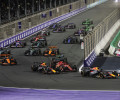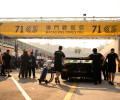Noise limitation and control in Karting : directions for use

PRESS RELEASE
In a constantly evolving society which advocates the need for more ecology and a reduction in all nuisances, the raging sound of some karts can create problems. Fully aware of the situation, the CIK-FIA, the International Karting Federation, has decided to respond and has been working for many months on limiting the karts’ noise.
“Generally speaking, the biggest issue came from gearbox karts of the KZ category”, explained Laurent Arnaud, the Engineer heading the CIK-FIA’s technical department. “But in order to act efficiently we had to come up with a precise control means which would have to be rigorous and in compliance with reality. This is why we have developed a system which allows the recording of noise on the track and no longer with a static measurement taken before or after the race.”
At it meeting of 15 June 2012 the FIA World Motor Sport Council validated the proposal of the Members of the International Karting Commission to limit noise to 108 dB and to impose on offender some penalties in terms of positions or time. As this decision is with immediate effect, the next international CIK-FIA races will already be concerned.
To develop its control system, the CIK-FIA has called on two engineering companies specialised in acoustics, which worked in close collaboration with the technical department of the Federation. Concretely, the noise is measured dynamically when the karts pass under an arch. “At a rhythm of 51,200 measurements per second, four aligned microphones record the noise variations”, added Laurent Arnaud. “Since the system is directly connected to the timekeeping it makes it possible to relate a sound and the kart which produces it. However, if several karts run in a tight field the measurement is discarded. We have programmed the system so that it leaves as a minimum 5 tenths of second between the passing of two karts to ensure that the measurement is valid.”
Before the application of this new rule the CIK-FIA had invited the Manufacturers to three test days: one at Sarno in September 2011, one at Castelletto in December and the final one at Castelletto last April. “Those who so wished could therefore test several solutions and had enough time between the different sessions to develop new ones”, pointed out Laurent Arnaud. “Some of the Manufacturers have considerably and efficiently worked, thus managing to get below the 108 dB limit without reducing their performance level or affecting the reliability of the engines.”
Right from the forthcoming races, and in particular the World Cups for KZ1 and KZ2 in September at Sarno, in Italy, failing to respect the noise limit will therefore entail penalties. In case of breaches to the limit during qualifying practice, the Driver will be moved back 3 grid places for a 1 dB excess, 6 places for 2 dB and 9 places for 3 dB. In case of excesses over 3 dB, the Driver will as a minimum be moved to the last starting position. The same principle will be applied in the qualifying heats and final phase, but with time penalties: 3 seconds for a 1 dB excess, 6 seconds for 2 dB and 9 seconds for 3 dB. In case of excesses over 3 dB, the Driver will as a minimum be classified last.
“The CIK-FIA is concerned with the environmental impact of its activities and of Karting activities in general”, stated Shaikh Abdulla bin Isa Al Khalifa, President of the CIK-FIA. “We know that some tracks are currently jeopardised in certain countries because of noise pollution, so we had to react. By taking measurements in our events and by cooperating with the Manufacturers so that they develop means of reducing noise, we have made a major step for the development of our sport.”
For Media Information purposes - No regulatory value.

 Facebook
Facebook Twitter
Twitter






